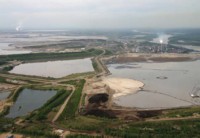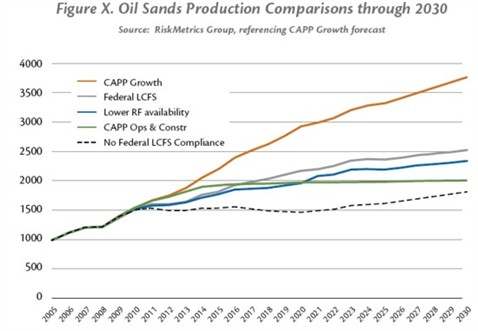Financial Risks of Oil Sands Greater than BP's Gulf Oil Spill

While public attention is focused on widespread environmental and
financial damage from the Gulf of Mexico oil spill, a new Ceres
report released today shows that the environmental and financial
risks of producing oil in Canada’s vast oil sands region may be
even greater.
Alberta’s oil sands are already the world’s largest energy
project-with $200 billion in funds committed from the world’s
leading oil producers, including BP, ExxonMobil and Shell.
However, these producers face numerous environmental, production
and distribution challenges that will grow as the oil sands
industry pushes to boost production amid tighter regulations and
resource constraints, concludes the Ceres-commissioned report authored by RiskMetrics
Group. Oil sands companies in Alberta are already producing 1.3
million barrels a day, and their goal is to triple production by
2030.
“The risks for companies involved in developing Canada’s oil
sands are arguably greater than those in the Gulf of Mexico,” said
Ceres president Mindy Lubber, whose group commissioned the report,
Canada’s Oil Sands: Shrinking Window of
Opportunity. “The energy-and water-intensive nature of
oil sands, combined with climate change regulations, permitting
obstacles and other challenges, are a recipe for diminishing
revenues and returns if not properly managed.”
The report recommends that oil sands companies move quickly to
examine and respond to these multiple challenges facing the
industry and that investors press the companies for such action,
too. Investors have already filed shareholder resolutions on the
oil sands topic with Royal Dutch Shell, ExxonMobil, BP and
ConocoPhillips. The Shell resolution will be voted on at tomorrow’s
annual corporate meeting in London. ExxonMobil’s shareholder
resolution is up for a vote on May 26.
While just over half of U.S. oil comes from overseas countries
like Venezuela and Saudi Arabia, the fastest growing source is from
two North American regions - the Gulf of Mexico and Canada’s vast
oil sands region. Oil production from these two areas has grown to
three million barrels a day in recent years, supplying more than 15
percent of total U.S. oil needs.
While deepwater oil production in the Gulf has huge
environmental risks that are obvious today, this report concludes
that long-term risks from development in Canada’s oil sands region
are arguably greater. Many of these risks stem from already-high
financial costs and the environmental impacts of transforming
highly viscous bitumen into synthetic crude oil - a process that
requires vast amounts of energy and water.

“Investors need to question whether this is a wise use of
resources,” says Doug Cogan, a report co-author and director of
climate risk management for RiskMetrics Group. “The oil sands
process takes natural gas-the cleanest-burning and lowest-carbon
fossil fuel-to turn one of the dirtiest and highest-carbon fuels
into a saleable product. Large volumes of freshwater are also
consumed in the process, and end up in toxic tailings
ponds.
It’s like the Gulf of Mexico spill, but playing out
in slow motion. From a climate and ecological perspective,
we’re really no better off.”
“This report makes clear that oil sands companies must do more
to analyze the far-reaching risks from current and future
production in Alberta,” said Jack Ehnes, chief executive officer of
the California State Teachers’ Retirement System (CalSTRS), the
nation’s second largest public pension fund. “With nearly $1.9
billion invested in the equity securities of BP, Shell, Exxon and
ConocoPhillips combined, we have quite of teachers’ money at stake
here. We need to ensure these companies are properly recognizing
and managing oil sand risks.”
The Ceres/RiskMetrics report examines how new carbon-reducing
and land reclamation regulations, climate change and other
environmental and social issues could create additional cost- and
profit-margin constraints on future oil sands production.
Among the report’s key findings:
Shrinking profit margin: The costs of
producing oil sands - already the world’s most expensive source of
new oil - are rising and will continue to do so due to the
onset of carbon pricing, higher input commodity prices, and rising
costs for water treatment and land reclamation. As a result, global
oil prices will need to remain high - possibly approaching $100 per
barrel - to ensure a competitive rate of return on $120 billion in
planned expansion projects. Oil sand operators must also be mindful
that if global oil prices get too high, between $120 and $150 a
barrel, it will likely reduce global oil demand and shift markets
in favor of alternative fuels.Vulnerability to changes in U.S.
Markets: Presently, the vast majority of of the 1.3
million barrels being produced every day flows to the United
States. Long-term access to this market is jeopardized, however, by
emerging low-carbon fuel standards in the U.S. that will require a
lower carbon intensity in transportation fuels. These fuel
standards, already adopted in California, will put carbon-intensive
oil sands fuel at a distinct disadvantage because oil sands output
will likely have to be mixed with next-generation biofuels that are
not yet being produced on a commercial scale.Other Distribution Obstacles:
Transporting expanded oil sands production west to China and other
Asian markets is another alternative. However, there is strong
opposition to building pipelines to Canada’s West Coast from
Aboriginal communities who have significant rights under the
Canadian constitution.Water and Other Resource Constraints:
Oil sands production is highly water intensive, with up to four
barrels of freshwater consumed for every barrel of oil produced
from surface mining extraction. Water withdrawals from the
Athabasca River watershed are already restricted during winter
months to protect fish habitat. If oil sands production volume
grows according to companies’ estimates, some oil sands mining
operations could exceed their wintertime allowances as early as
2014, causing possible production interruptions. Climate change may
also exacerbate this situation; glaciers feeding into the Athabasca
River watershed are already shrinking.Growing Land Reclamation
Costs/Liability: After 40 years of production, no oil
sand companies have yet fully reclaimed the extensive tailings
ponds used for holding polluted wastewater. This is because the
fine tailings in these ponds take decades to settle out. These
tailing ponds, already covering an area the size of Washington
D.C., pose risks of contaminating adjoining lands and water
resources, and present health problems in downstream communities.
Alberta’s Directive 74 requires oil sands miners to speed up
remediation of existing ponds - an order that creates especially
large liabilities for the industry’s legacy miners such as Suncor
and Syncrude.
The report calls on oil sands companies to take a cautious,
incremental approach to oil sands expansion that fully analyzes and
plans for managing these multiple risks before making additional
major investments.
The report specifically recommends that oil sands producers:
- Review the lasting impact of their proposed development plans
and pursue more pro-active, incremental strategies to manage
environmental and social risks; - Provide guidance for assumed oil, natural gas and carbon prices
in future production forecasts. - Do a better job of articulating to community groups and other
stakeholders their strategies for land use planning, water
management and carbon mitigation; - Disclose information from these more detailed evaluations to
investors; - Develop stronger ties with the U.S. biofuels industry both for
speeding up development of advanced biofuel capacity and sharing
existing infrastructure, such as oil sands pipelines that already
feed into the U.S. Midwest.
“All oil is getting dirtier and harder to
produce,” Bob Walker, vice president of sustainability at Northwest
and Ethical Investment in Canada.
“With Chinese investment and demand set to grow outside the
U.S., oil sands production is likely to grow. Investors need to be
aware of the environmental and social risks and engage oil sands
companies to improve disclosure, operational performance and to
make technological investments to reduce environmental and social
impacts.”
“We recognize that oil companies will continue to invest in the
oil sands,” continued Lubber, “but they shouldn’t do so blindly.
Investors need assurances that the risks outlined in this report
are being taken into account. This includes the fact that
carbon will be regulated, that water will be increasingly scarce,
that tailings ponds need to be cleaned up, and that doing all this
will be expensive. Companies need to build solutions in up front or
they shouldn’t be building these projects at all.”
The full report is available at
target=”_blank”>http://www.ceres.org//oilsandsreport and
Source: www.ceres.org

